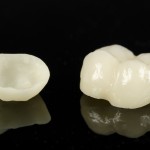
Amelogenesis imperfecta (AI) is a rare, genetically determined defect in enamel mineralization. It is classified into 4 main types with 14 subtypes being recognised. The main types are: hypoplastic (Type 1); hypomaturation (Type II); hypocalcified (Type III); and hypomaturation/hypoplasia/taurodontism (Type IV). Patients often suffer adverse aesthetic affects as a result of tooth discolouration and small crown size, with the most severely affected patients exhibit rapid loss or fractures of enamel, as well as alterations in enamel thickness, color, and shape.
The aim of this study was to compare the quality and longevity of 2 crown types-Procera and IPS e.max Press in adolescents and young adults with AI.
Methods
Patients with a clinically verified AI diagnosis, confirmed by an anamnestic family history or histology examination. Patients were randomised to receive either Procera or IPS e.max Press using a split mouth approach. Tooth sensitivity was assessed on a VAS for whole dentition. Teeth were followed up at 1 and 2 years. Restorations were assessed using Ryge criteria.
Results
- 27 patients aged 11-22yrs were included
- 227 crowns 151 in hypoplastic AI, 76 in hypomineralized/hypomatured AI) were made.
- 119 Procera crowns and 108 IPS e.max Press crowns were fitted
- The observation period ranged between 24 and 60 months
- No significant differences were observed between the two groups
- After 2 y, 97% of the crowns in both crown groups had excellent or acceptable quality
- Endodontic complications occurred in 3% of crowns
Conclusions
The authors concluded:
We found no significant differences between Procera and IPS e.max Press crowns with regard to quality and longevity. Crown therapy also resulted in decreased sensitivity problems in young AI patients. It seems to be possible to perform early crown therapy without severe complications in young patients with AI.
Comments
This small trial has demonstrated good short-term outcomes for both types of crown types-Procera and IPS e.max Press in adolescents and young adults. While only 3% of crows suffered adverse effects as the authors note this may be too short a period for the presentation of late complications. Traditional approaches to managing patients with AI has involved the use of stainless steel crowns on molars so demonstration that ceramic restorations are effective in the short term is welcome.
Links
Pousette Lundgren G, Morling Vestlund GI, Trulsson M, Dahllöf G. A Randomized Controlled Trial of Crown Therapy in Young Individuals with Amelogenesis Imperfecta. J Dent Res. 2015 Aug;94(8):1041-7. doi: 10.1177/0022034515584385. Epub 2015 Apr 29. PubMed PMID: 25924855.

Amelogenesis imperfecta: study suggests good outcomes from crown therapy http://t.co/xwpESgf8JJ
Good outcomes from crown therapy in amelogenesis imperfecta http://t.co/xwpESgf8JJ
Amelogenesis imperfecta- good outcomes from crown therapy http://t.co/xwpESgf8JJ
Crown therapy produced good outcomes in amelogenesis imperfecta http://t.co/xwpESgf8JJ
Don’t miss – Amelogenesis imperfecta: study suggests good outcomes from crown therapy http://t.co/xwpESgf8JJ